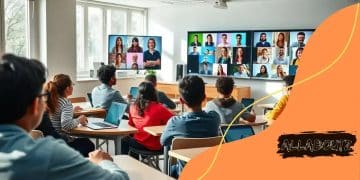How AR is being used for hands-on learning experiences

Augmented reality (AR) is transforming education by creating engaging, interactive learning experiences that enhance understanding, foster collaboration, and personalize education while addressing challenges such as cost and the need for teacher training.
How AR is being used for hands-on learning experiences is changing the way students engage with educational content. Imagine a classroom where anatomy comes to life or history is experienced firsthand. That’s the power of augmented reality!
Understanding augmented reality in education
Understanding augmented reality in education is crucial for embracing the future of learning. This innovative technology enhances the way students interact with information, offering immersive experiences that traditional methods cannot provide.
By merging digital content with the real world, augmented reality can transform a simple lesson into an engaging journey. For instance, when students explore space, they can view 3D models of planets right in their classroom, fostering curiosity and excitement.
What is Augmented Reality?
Augmented reality (AR) overlays digital information onto the real world. This means students can use smartphones or tablets to access interactive images, videos, and data, all while remaining in their physical learning environment. The benefits of this technology are significant.
- Increased engagement: Students are more likely to participate when lessons are interactive.
- Enhanced understanding: Complex subjects become clearer through visual representations.
- Personalized learning: AR allows teachers to tailor content to meet individual student needs.
Another key aspect of augmented reality in education is its ability to foster collaboration. Students can work together on projects, sharing their findings using AR tools, which cultivates teamwork and problem-solving skills. As they navigate these immersive environments, learners develop critical thinking skills, as they must interpret and analyze the information presented to them.
Research suggests that students retain information better when it’s presented through augmented reality. This retention is often attributed to the enriched learning experiences that stick in their minds longer than traditional formats. For example, a lesson on biology can lead students to explore the anatomy of a heart in 3D, examining every chamber and valve.
The Future of AR in Education
The future of augmented reality in education looks promising. As technology advances, more schools are expected to adopt AR tools to complement their curricula. This integration not only makes learning more enjoyable but prepares students for a tech-driven world.
In conclusion, understanding augmented reality in education is essential for teachers and students alike. By recognizing its potential, everyone can contribute to a more engaging, effective, and collaborative learning environment that prepares students for future challenges.
Benefits of AR for hands-on learning
The benefits of augmented reality (AR) for hands-on learning are impressive and transformative. By incorporating AR into educational settings, teachers create opportunities for students to engage with material in ways that were previously unimaginable.
One significant advantage is increased engagement. Students often find traditional lectures dull, but when lessons are brought to life through AR, their interest soars. Imagine a history class where students can visualize ancient ruins right in their classroom!
Enhanced Understanding
Augmented reality also promotes better comprehension of complex subjects. For example, in science classes, students can explore the human body in 3D, examining organs and systems from various angles. This immersive experience helps them grasp intricate concepts more effectively.
- Interactive Learning: With AR, students can interact with digital elements, making learning more fun.
- Real-World Application: Students get to see how concepts apply in real life, bridging the gap between theory and practice.
- Immediate Feedback: Engaging with AR allows instant feedback on their understanding, helping them improve quickly.
Moreover, augmented reality encourages collaboration among students. Working together on AR projects fosters teamwork and communication skills. As they tackle challenges, students learn to share ideas and build off each other’s strengths.
Another benefit is that AR can cater to different learning styles. Visual learners thrive when they see concepts represented spatially, while kinesthetic learners gain from interacting with digital objects. In this way, AR creates an inclusive learning environment for everyone.
Accessibility and Flexibility
AR can enhance the accessibility of learning materials. For students with disabilities, interactive content can provide alternatives that meet their specific needs. This technology allows educators to present materials in diverse formats, ensuring all students can engage meaningfully.
As we explore the benefits of augmented reality for hands-on learning, it’s clear that integrating this technology into education can lead to remarkable advancements. Students not only gain knowledge but also develop essential skills that prepare them for the future.
Real-world applications of AR in classrooms

Real-world applications of augmented reality (AR) in classrooms are revolutionizing the way students learn and interact with educational content. Schools around the globe are adopting AR technology to create engaging and interactive learning environments.
One notable application is in the field of science education. With AR, students can visualize complex processes like photosynthesis or the structure of molecules. Through interactive 3D models, learners can better understand these concepts, enhancing their learning experience.
History Comes to Life
In history classes, AR allows students to experience significant events as if they were there. For example, learners can view ancient civilizations’ architecture or reenact battles through immersive simulations. This hands-on experience helps students connect emotionally with historical events, leading to a deeper understanding and retention of knowledge.
- Interactive Field Trips: Instead of traditional field trips, students can explore new worlds right from their classroom using AR applications.
- Visualizing Geography: AR can depict geographical features like mountains or rivers in real-time, allowing students to learn about their environment interactively.
- Language Learning: AR can help in language classes by placing students in scenarios where they can interact with virtual characters to practice their language skills.
Furthermore, educators can use AR for mathematics lessons, helping students visualize difficult concepts such as geometry in a 3D space. This visual approach enables students to grasp formulas and theorems more readily, making learning fun and effective.
As more teachers use augmented reality tools, we see improved student motivation and collaboration. Group projects become more interactive as students can manipulate virtual elements together, bringing their ideas to life.
Customizable Learning Experiences
Another exciting application of AR is in creating customizable learning paths. Teachers can tailor lessons based on individual student needs, using AR to provide additional resources or challenges. This adaptability ensures that every learner can progress at their own pace.
By integrating augmented reality into the curriculum, educators open doors to endless possibilities. The future of learning is here, providing students with the tools needed to thrive in a digital world.
Challenges of implementing AR technology
The challenges of implementing augmented reality (AR) technology in education are significant, but they can be overcome with the right strategies. As schools explore AR, understanding these obstacles helps in creating effective solutions.
One major challenge is the cost associated with adopting AR technology. Schools may need to invest in new hardware, such as tablets or AR glasses, as well as software licenses for applications. Budget constraints can limit the accessibility of this technology for many institutions.
Training and Support
Another obstacle is the need for proper training for teachers and staff. Educators must feel comfortable using augmented reality tools to integrate them successfully into their lessons. Without adequate training and ongoing support, teachers may struggle to harness the full potential of AR.
- Teacher Training: Providing professional development sessions to familiarize teachers with AR technology.
- Technical Support: Ensuring quick access to help if problems arise when using AR tools.
- Resource Allocation: Planning budgets for both training and implementation to facilitate a smooth transition.
Moreover, there can be technical issues related to the implementation of AR. These may include software bugs, compatibility problems, or issues with network connectivity. Schools must ensure they have the necessary infrastructure to support AR, which can be a considerable barrier to adoption.
Additionally, creating content for augmented reality experiences requires skilled personnel. Educators and content creators must work together to develop relevant, engaging AR content that enhances learning experiences. This collaboration can be time-consuming and complex.
Equity and Access
Equity is another critical concern. Not all students may have the same access to technology at home, leading to disparities in learning opportunities. Schools need to find ways to ensure that all students can benefit from AR experiences, whether in the classroom or at home.
Despite these challenges, the potential benefits of augmented reality in education offer a strong incentive to overcome obstacles. By addressing these issues head-on, schools can create an innovative and engaging learning environment for all students.
Future trends in AR for education
Future trends in augmented reality (AR) for education are set to reshape how students learn and engage with content. As technology advances, the potential for AR in the classroom continues to grow, promising exciting developments that enhance educational experiences.
One major trend is the increase in affordability of AR technology. As devices become more accessible, schools can integrate AR tools without significant financial strain. This change allows a wider range of institutions to adopt innovative teaching methods, making learning more interactive.
Personalized Learning Experiences
Another significant trend is the push for personalized learning through AR. Educators will be able to tailor lessons to meet the unique needs of each student. With AR, students can explore subjects at their own pace, revisiting complex concepts until they fully understand them.
- Adaptive Learning: AR applications will adjust content based on student performance, ensuring that each learner receives the right challenges.
- Student-Created Content: Future trends will allow students themselves to create AR experiences, enhancing their engagement and creativity.
- Data-Driven Insights: Educators can use analytics from AR interactions to refine teaching strategies and improve classroom outcomes.
In addition, collaborative learning will become more prevalent with AR. Virtual environments enable students to work together on projects, no matter their physical location. This trend fosters teamwork and communication skills that are vital in today’s world.
Integration with Other Technologies
The integration of AR with other technologies, such as virtual reality (VR) and artificial intelligence (AI), is also on the horizon. This combination will create more immersive and dynamic educational experiences. For instance, simulations that blend AR with VR can provide realistic scenarios for students, enhancing their understanding of complex subjects.
Furthermore, we can expect to see more use of AR in remote learning. As distance education continues to grow, AR can bridge the gap between in-person and online learning, offering interactive elements that enrich virtual classrooms.
Ultimately, the future of augmented reality in education looks promising. By embracing these trends, schools can create engaging, effective, and inclusive learning environments that prepare students for a rapidly evolving world.
The conclusion summarizes the key insights about the role of augmented reality (AR) in education. By embracing AR technology, schools can create more engaging and interactive learning environments. This technology not only helps students understand complex subjects but also promotes personalized learning experiences that cater to different needs. As AR continues to evolve, its integration with other technologies will further enhance collaboration and accessibility, preparing students for a future driven by innovation.
FAQ – Frequently Asked Questions about Augmented Reality in Education
How does augmented reality enhance learning in classrooms?
Augmented reality makes learning interactive by allowing students to visualize and engage with complex subjects in a hands-on manner.
What are some examples of augmented reality applications in education?
Examples include 3D models in science classes, historical reenactments, and interactive language learning experiences.
What challenges do schools face when implementing AR?
Challenges include high costs, the need for teacher training, technical issues, and ensuring equal access for all students.
What is the future potential of AR in education?
The future of AR in education includes personalized learning experiences, integration with other technologies, and increased collaboration among students.





